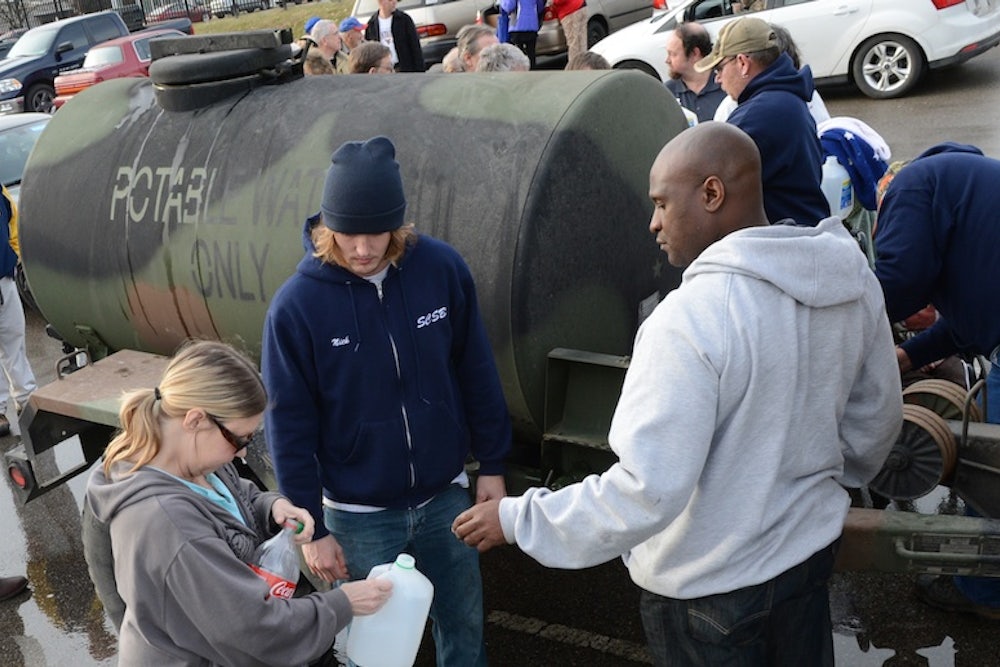Over the weekend, West Virginia authorities lifted the last remaining tap-water ban in effect since a January 9 chemical spill at the Freedom Industries plant in Charleston contaminated the water supply of 300,000 people. But in a press conference Monday, Governor Earl Ray Tomblin hardly inspired confidence that the water was safe to drink, saying, “It’s your decision” to choose to drink the water and “I’m not going to say absolutely, 100 percent that everything is safe.” Tomblin, a Democrat, later added, “It’s a very complicated issue. I’m not a scientist, you know.”
There's the problem. Scientists don't know much, either, about the leaked chemical, "crude MCHM," and on Tuesday a Tomblin spokeswoman confirmed that a second chemical, a modified form of PPH, also leaked into the water during the spill. The Center for Disease Control insists that 1-part-per-millon or less of crude MCHM isn't harmful, but adds, "Due to limited availability of data, and out of an abundance of caution, pregnant women may wish to consider an alternative drinking water source until the chemical is at non-detectable levels in the water distribution system…. Few studies on this specialized chemical exist and most have been conducted on animals.” The CDC reported that toxicologic information on PPH is also limited but does “not suggest any new health concerns.”
This is little comfort to #aquapocalypse victims whose tap water still smells like licorice, despite following a U.S. Agency for Toxic Substance and Disease Register (ATSDR) recommendation that they flush their plumbing systems until the odor goes away. Dr. Paul F. Ziemkiewicz of the West Virginia Water Research Institute explained to me that crude MCHM is a surfactant that lowers the surface tension between a liquid and a solid—in this case, water and coal. It's a detergent of sorts, cleaning coal by separating it from non-burnable (and thus non-usable) mined substances such as shale. Because crude MCHM is only slightly soluble in—and lighter than—water, it is possible that traces of the chemical could settle at the top of water tanks in homes, continuing to contaminate its contents even after households have flushed their plumbing system. Little is known, too, about PPH, which made up five percent of the leaked tank’s total capacity. According to the Charleston Gazette, "A Freedom Industries data sheet on the chemical says it can irritate the eyes and skin and is harmful if swallowed. The sheet lists the material as less lethal than Crude MCHM but also says no data are available on its long-term health effects."
With the state sending mixed messages, West Virginians affected by the spill are hoping scientists can provide more clarity on the chemicals. “The governor has closed the book on this disaster," said Rob Goodwin, an activist in Charleston, "and it’s unfortunate because the disaster relief aid as it was, especially in rural areas, is going to stop because the state is no longer seeing this as an emergency anymore.” Goodwin thinks that in the absence of a regulatory standard, the least the state and the water supplier, West Virginia American Water, could do is clarify and expand the flushing instructions. (Goodwin advises draining hot water heaters completely and minimizing exposure by leaving the home during the process.) But the state has confused even this relatively simple matter. West Virginia authorities rejected ATSDR's flushing advice, and when asked about it Monday, Tomblin said, "I'm not aware that we did. I have not seen that."
No wonder there's still "a big demand" for the bottled water being trucked in by FEMA—a supply that, according to the West Virginia Division of Homeland Security, is only expected to last through the weekend.
